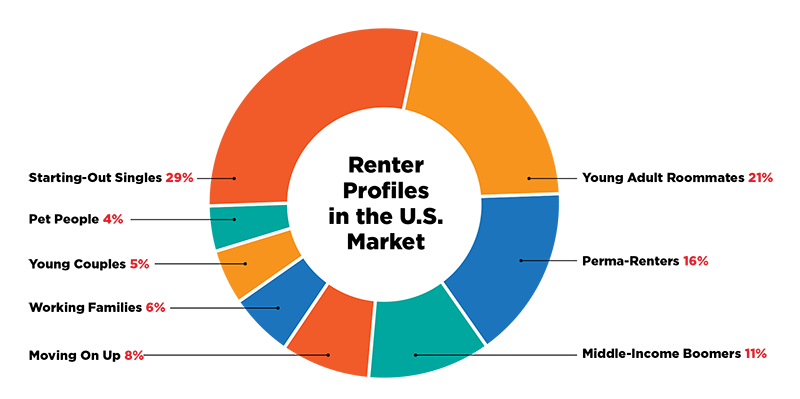A downtown-dwelling, 20-something with no spouse, no kids and a job in a high-paying profession: This profile should sound familiar if you’ve seen any news coverage of the apartment market in recent years. It’s the person most often described as being today’s apartment renter. And to the casual industry observer, it might seem that’s the only type of renter in today’s market.
In discussions about the nation’s apartment market, rental housing residents often are lumped into one large group. But the reality is far more nuanced.
To provide a more in-depth look at the apartment renter base, RealPage recently examined 5.7 million individual lease transactions in a statistical analysis of actual renter characteristics such as age, income, number of adults per household, marital status and the presence of children or pets in the unit.
Based on this analysis, eight distinct types of U.S. renter households emerged, as discussed in the Oct. 2 RealPage Asset Optimization webcast. Further, some types of households are more prevalent in certain local markets and in certain product types than others. To identify these various local trends, 25 large metros and 25 smaller markets across the country were studied.

Starting-Out Singles
 The biggest group identified, the “Starting-Out Singles” cluster, made up 29 percent of the renter base examined. On average, these were the youngest renters profiled, at 26 years old. With limited incomes and high rent-to-income ratios, the Starting Out Singles move around quite a bit, choosing smaller apartments in Class B and C properties, usually in the suburbs. Only a small slice of this group gravitates toward Class C units in the urban core. Big metros heavy in Starting Out Singles include Indianapolis, Salt Lake City, San Jose and San Diego. Among the smaller metros, heavy concentrations of the youngest renters are in Salinas, Calif.; Des Moines, Iowa; Colorado Springs, Baton Rouge, La.; and Montgomery, Ala.
The biggest group identified, the “Starting-Out Singles” cluster, made up 29 percent of the renter base examined. On average, these were the youngest renters profiled, at 26 years old. With limited incomes and high rent-to-income ratios, the Starting Out Singles move around quite a bit, choosing smaller apartments in Class B and C properties, usually in the suburbs. Only a small slice of this group gravitates toward Class C units in the urban core. Big metros heavy in Starting Out Singles include Indianapolis, Salt Lake City, San Jose and San Diego. Among the smaller metros, heavy concentrations of the youngest renters are in Salinas, Calif.; Des Moines, Iowa; Colorado Springs, Baton Rouge, La.; and Montgomery, Ala.
Young Adult Roommates
 Like the Starting-Out Singles, those in the “Young Adult Roommates” group – renters around age 28 in households with two or more adults – also like to move around. The Young Adult Roommates, which comprise 21 percent of the households studied, have the shortest length of stay among all groups. They tend to live in higher-end suburbs or the urban core, typically opting for Class A or B+ product.
Like the Starting-Out Singles, those in the “Young Adult Roommates” group – renters around age 28 in households with two or more adults – also like to move around. The Young Adult Roommates, which comprise 21 percent of the households studied, have the shortest length of stay among all groups. They tend to live in higher-end suburbs or the urban core, typically opting for Class A or B+ product.
Though the individual income level in this group is comparable to those in the Starting Out Singles, Young Adult Roommates take advantage of combined incomes and opt for pricier units. These households are most common in San Jose, where 41 percent (double the national average) of the South Bay Area’s apartment renter households are Young Adult Roommates.
Also garnering a large share of these renters are San Diego, Orange County, San Francisco, Boston and Los Angeles, some of the country’s most expensive apartment markets. Smaller markets where Young Adult Roommate households are prevalent are Ventura County, Salinas and Colorado Springs.
Perma-Renters
 Despite accounting for a moderate share of the renter base (16 percent), “Perma-Renters” are perhaps the industry’s most overlooked households. These residents, on average, are in their early 40s, single and always renew their expiring leases at least once.
Despite accounting for a moderate share of the renter base (16 percent), “Perma-Renters” are perhaps the industry’s most overlooked households. These residents, on average, are in their early 40s, single and always renew their expiring leases at least once.
They have moderate annual incomes around $50,000, which allow them to afford Class B units in the suburbs without much of a strain on their budgets. Because these renters don’t move around as much as the younger crowd, their propensity to renew leases offers a valuable component to an apartment rent roll.
Not surprisingly, this renter base frequently lives in metros where Class B apartments tend to perform especially well, with large concentrations in Las Vegas, Atlanta, Washington, D.C., Dallas and Houston.
Middle-Income Boomers
 Middle-Income Boomers represent 11 percent of all renter households. While some of the affluent Baby Boomers are busy downsizing to luxury urban core areas, this more prominent slice of the Boomer rental population is not.
Middle-Income Boomers represent 11 percent of all renter households. While some of the affluent Baby Boomers are busy downsizing to luxury urban core areas, this more prominent slice of the Boomer rental population is not.
Middle-Income Boomers report more modest incomes, possibly because many of them are drawing on retirement savings for day-to-day expenses. They are mostly single-person households and are 62 years old, on average. Though a handful of these renters extend into the urban core, this group tends to live in small units, usually in Class B or C product in the suburbs.
Among all renter segments, this group has the highest propensity to renew expiring leases. Middle-Income Boomers tend to reside in areas with slow-growth economies and retirement hubs. Among bigger markets, the top spots for these renters are Cleveland and Las Vegas, while small-market favorites are Sarasota, Fla.; Grand Rapids, Mich.; Wichita, Kan.; and Albany, N.Y.
Moving On Up
 A smaller share, about 8 percent, of renter households is comprised of residents in their early 30s who are fueling demand for new, upscale properties. The “Moving-On-Up” renters are nearly always single and living alone, usually in downtowns or top-tier suburban locations close to large career centers. These renters prefer metros with higher for-sale housing prices, where purchasing can be a challenge in preferred neighborhoods.
A smaller share, about 8 percent, of renter households is comprised of residents in their early 30s who are fueling demand for new, upscale properties. The “Moving-On-Up” renters are nearly always single and living alone, usually in downtowns or top-tier suburban locations close to large career centers. These renters prefer metros with higher for-sale housing prices, where purchasing can be a challenge in preferred neighborhoods.
Large metros examined with the most share of Moving-On-Up renters were San Francisco, Denver, Los Angeles and Austin. Among the smaller markets, Knoxville logged the largest portion of this renter base.
Working Families
 “Working Families” account for just 6 percent of renter households, a number limited by the general preference of these families to opt for single-family rental homes rather than apartments. Working Families are comprised of one or more children, but not always two adults. In fact, a sizable portion of this group is made up of single-parent households. The average age of the adult members is early- to mid-30s.
“Working Families” account for just 6 percent of renter households, a number limited by the general preference of these families to opt for single-family rental homes rather than apartments. Working Families are comprised of one or more children, but not always two adults. In fact, a sizable portion of this group is made up of single-parent households. The average age of the adult members is early- to mid-30s.
Working Families generally live in slow-growth suburbs, usually in the largest units in Class C properties. Interestingly, in big metros, the percentage of Working Families in the renter mix never reaches beyond the U.S. average. The top concentrations are only about 7 percent of the total in Orlando and Washington, D.C. Working Families comprise more of the renters in a few small markets, including Wichita, Palm Bay, Florida and Grand Rapids.
Young Couples
 “Young Couples” comprise 5 percent of the renter base. Like the adult members of the Working Families segment, those in the Young Couples sector tend to be in their mid- to-late 30s and are more affluent than the younger renters in the Moving On Up category. Young Couples are comprised of two-adult households, and the members are nearly always married.
“Young Couples” comprise 5 percent of the renter base. Like the adult members of the Working Families segment, those in the Young Couples sector tend to be in their mid- to-late 30s and are more affluent than the younger renters in the Moving On Up category. Young Couples are comprised of two-adult households, and the members are nearly always married.
These residents prefer new, upscale properties and focus on locations like San Francisco, Los Angeles, Denver, Boston, Chicago, Austin and Seattle – all higher barrier-to-entry markets. Like the Moving On Up renters, Young Couples gravitate toward markets with high for-sale housing prices. Thus, even with larger incomes, purchasing a home can be a challenge in these favored locations.
Pet People
 The smallest group, amounting to 4 percent of renter households, is the “Pet People.” With two or more pets per household, these animal lovers are in their early 30s with annual incomes averaging in the middle of the pack at about $65,000. They are living in a mix of one- and two-adult households. Denver is a large metro where Pet People appear more frequently, while smaller markets with concentrations of these households are Knoxville, Sarasota and Colorado Springs.
The smallest group, amounting to 4 percent of renter households, is the “Pet People.” With two or more pets per household, these animal lovers are in their early 30s with annual incomes averaging in the middle of the pack at about $65,000. They are living in a mix of one- and two-adult households. Denver is a large metro where Pet People appear more frequently, while smaller markets with concentrations of these households are Knoxville, Sarasota and Colorado Springs.
